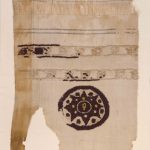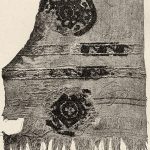| Artefact ID | 1063 |
| TM ID | - |
| Findspot (DEChriM ID) | - () | Class | Garment/adornment/accessories, Liturgical object |
| Material | Wool, Linen |
| Description | Fragment of a large cloth or cover. It is made of undied linen and features fringes on one of the sides, an indication that the piece corresponds to one of the narrow sides of what was originally a long rectangular textile item. On the base linen fabric, a little decentred, is a circular decorative motif made of dark brown wool, in the centre of which lies a small crux ansata. A similar medallion, datable to the 4th century is held in the Musée royal de Mariemont (Bruwier 1997: 144-145). Another strikingly similar textile fragment is part of the Ernst von Sieglin collection (von Sieglin, Pagenstecher 1923: 38). It displays the same fringes and woven circle with an inscribed crux ansata in the centre. To these, another circular motif, with a sort of diamond in its centre and a cross inside it, was later added, stitched on, rather than woven. This fragment is to be considered as part of the same object as the item held by the Staatliche Museen. The cloth was probably covering an altar table. |
| Selection criteria | Christian symbols/gestures/isopsephy |
| Date from | 310 |
| Date to | 411 |
| Dating criteria | Radiocarbon dating (unpublished). |
| Absolute/relative date | Absolute date |
| Archaeological context | Unknown. Acquired in 1900 from the Carl August Reinhardt collection. |
| Accession number | Berlin, Staatliche Museen, MBK-Inv.-Nr. 9137 |


 Json data
Json data





